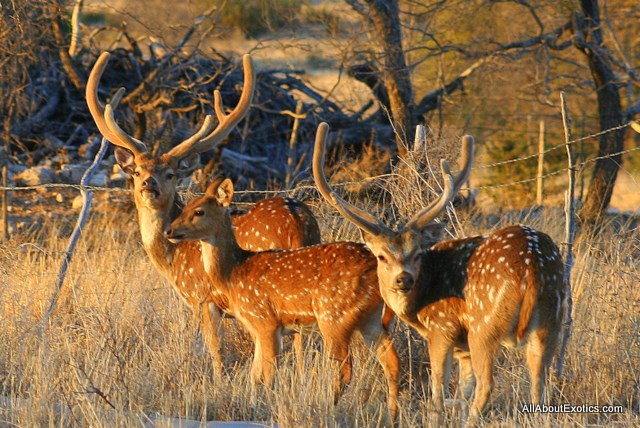Axis axis
Axis deer
Synonym(s):
Class: Mammalia
Order: Artiodactyla
Family: Cervidae

Photographer: unknown
Source: http://www.allaboutexotics.com/exotic-species/axis/
Description
Axis deer (Axis axis) are easily identified by an orange coat with white spots similar to a whitetail fawn. Mature males and females have white patches on their throat while only mature males have antlers with an average of 6 points per antler. Female axis deer do not grow antlers and have a mature body size of 90 to 150 lbs while males weigh an average of 150 to 250 pounds. Behavior of axis deer is nearly identical to native whitetail deer with majority of activity occurring at dusk and dawn. Herds are comprised of males and females of various ages throughout the year.
Ecological Threat: Axis deer are known to occupy the same ecological niche as whitetail deer. This means they compete with whitetail deer for available resources. With an increased resistance to native diseases, axis deer are not susceptible to the same population decreases resulting from local disease outbreak. This would allow the axis deer populations to grow out of control, while the whitetail deer suffer from local disease outbreaks. Local farmers are at risk of damage caused by axis deer populations growing and foraging in cultivated fields or gardens.
Biology: The average lifespan of axis deer is 9 to 13 years with documented cases of 20 years in captivity. Female axis deer reach maturity at 2 and remain fertile until 15 years of age. Male axis deer compete for females during their rut season by fighting other males. The height of the rut occurs in June and July but has been observed in all parts of the year. In Texas, the majority of axis deer fawns are born from January to April following a 210-238 day gestation cycle. Only one fawn is typically born during each pregnancy, but females go through estrous multiple times in one year.
History: Axis deer were introduced in 1932 as a game meat. They were kept on farms or controlled hunting sites for food purposes. Since their introduction, axis deer have escaped captivity and established in Texas, with over 6,000 free ranging animals and 40,000 kept on private hunting ranges.
U.S. Habitat: Axis deer feed on grass and sedges in fields near wooded or sheltered areas. They can be found in open areas during warm periods of the day, but are primarily active at dusk or dawn. Since the axis deer prefer warm weather they thrive in the state of Texas.
Distribution
Native Origin: India, Nepal, and Sri Lanka
U.S. Present: CA, HI, TX
Management
Management of axis deer is facilitated by legalized hunting with the purchase of permits and permission to hunt on private ranges with an entrance fee. Hunting free range axis deer is by permit only so local parks and wildlife authorities can monitor populations. For more information about hunting axis deer in Texas click here.
Read more - Axis deer possession now illegal in Hawaii, Holoholo State News
References
Lane, Robert S., and Willy Burgdorfer. 1986. Potential role of native and exotic deer and their associated ticks (Acari: Ixodidae) in the ecology of lyme disease in California, USA. Zentralblatt für Bakteriologie, Mikrobiologie und Hygiene. Series A:Medical Microbiology, Infectious Diseases, Virology, Parasitology 263(1-2): 55-64.
Moe, Stein R., and Per Wegge. 1994. Spacing behaviour and habitat use of axis deer (Axis axis) in lowland Nepal. Canadian Journal of Zoology 72(10): 1735-1744.
Ramsey, Charles W. 1968. A drop-net deer trap. The Journal of Wildlife Management 32(1): 187-190.
Riemann H., M. R. Zaman, R. Ruppanner, O. Aalund, J. B. Jorgensen, H. Worsaae, and D. Behymer. 1979. Paratuberculosis in cattle and free-living exotic deer. Journal of American Veterinary Medical Association 174(8): 841-843.
Internet Sources
http://www.allaboutexotics.com
 Texas Invasive Species Institute
Texas Invasive Species Institute